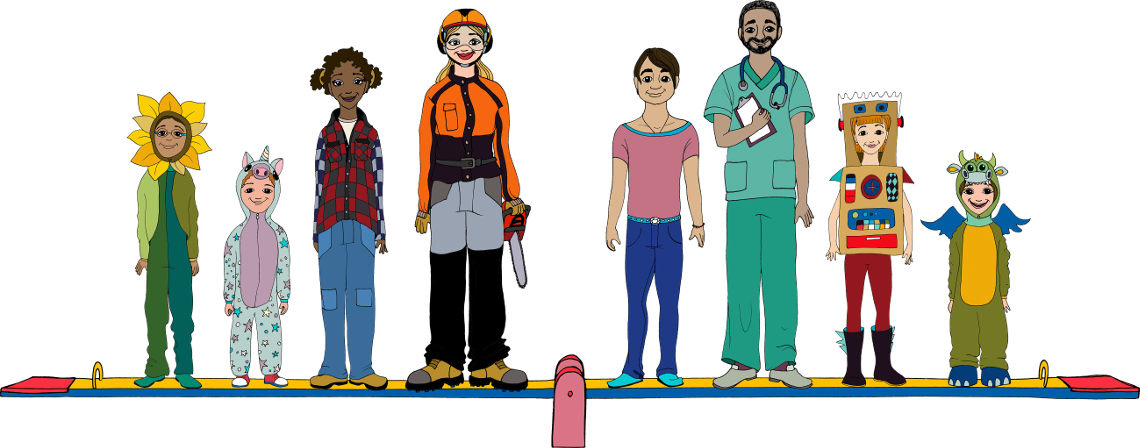Goals

Brief description of the issue
Family is the first socialization environment in the life of a child, whom there learns gender roles by observing his or her parents, who gender differentiate the most in the second year of his or her life (Amboulé Abath, 2009). It is therefore important that parents be also aware of gendered socialization to avoid reinforcing gender stereotypes with their children.
Daycare statement
When implementing certain measures or practices related to gender equality and to challenging gender stereotypes, it is ideal for daycares and other educational settings to involve parents in this process. To explain your approach to parents, you can share a statement of your position as a daycare, emphasizing that your mission is to ensure the development of all children in all areas of their development, regardless of their gender identity. This page contains videos that you can share with parents to raise their awareness of gender stereotypes in childhood and support them if they wish to discuss these issues with their children.
Gender stereotypes and education
This first video, created by the European Institute for Gender Equality, looks at what gender stereotypes are and how they influence our children from early childhood until the moment they choose their school subjects and career.
How to act as a parent?
How can we use our influence on our children, as parents, to show them different role models and a more gender-equal and positive way to interact as boys and girls, men and women?
Other videos:
Teaching our kids about gender equality and being great role models can sometimes be tricky. There are many ways possible you can do this and no wrong answer, as long as you are not considering gender as a factor that can limit your child’s aspirations, interests and activities. Look at the two following videos to get some ideas!
How to read a book and have fun
As soon as they enter kindergarden, boys from our region are already more vulnerable than girls in terms of communication skills. This is why it is important to start early literacy activities at a very young age, with boys AND girls. To make sure your reading activities with your children are fun and educational, here are a few tips from an organization called Avenir d’enfants (2014):
- Try to play with your facial expressions: a grimace will make them laugh out loud.
- Modulate your voice tone: a mouse doesn’t speak the same way as a hippopotamus!
- Add sounds: a dog barks, a train runs, a character knocks at the door.
- Use accessories: a plush can tell the story for you.
- Let the child manipulate the book by him or herself.
- Follow the words with your finger from left to right.
- Encourage your child to say words he or she can guess.
- Ask him or her questions.
- Listen to your children telling the story by looking at the images.
You can also do emerging literacy activities with your infants. Here are a few tips, again, from Avenir d’enfants (2014):
- For your infant, the book is a toy that can fly like a bird, jump like a frog or be used to say “peek-a-boo!”
- Prefer board books. Choose some with vivid colors, high contrasts and neat lines.
- Your infant will also like fabric or plastic books that he or she can chew.
- If your child is younger than one year old, you can benefit from the program Books for babies. Ask your local library for more information.
Choosing a book free of gender stereotypes
Children’s books carry along many gender stereotypes. It is, among others, through these stories and the representations of men and women they offer that children build their own gender identity (SCF, 2018). In order to limit young children’s buy-in of gender stereotypes, it is important to offer them books that break down those stereotypes instead of reinforcing them.
To guide you through your choice of books that are free of gender stereotypes, use this gender-equal book assessment grid. It holds a few questions to ask yourself when you look at characters, illustrations and roles represented in a book. This great blog post can also help you assess books you already have or that you are planning to purchase.
Here are a few suggestions of books encouraging children to have a gender-equal representation of the world:
- Twelve Books for Feminist Boys and Girls
- Five Children’s books that promote gender equality
- Ten of the best picture books to promote gender equality and identity
- 20 Children’s Books That Redefine Gender Roles
- Books about sexual and gender diversity
- 14 Children’s Books that Challenge Gender Stereotypes
- 2019 Amelia Bloomer List
- For Families: 5 Tips for Preventing and Reducing Gender Bias
- Gender stereotypes – What’s a parent to do?
- A parent’s guide to gender stereotypes
Finally, as reading is still considered today as a female activity and that, consequently, the literary offer is still very focused on female readers (and traditionally female interests), it is important to choose books that draw boys’ interests to hook them up with a subject they like, and then bring them to diversify their reading choices gradually.
How to challenge gender stereotypes when we are reading a “traditional” book?
Trying to deconstruct and uncover gender stereotypes in an early childhood educational setting doesn’t imply removing all books portraying stereotypical representations of boys and girls, nor does it require using only books of which the primary goal is to tackle gender stereotypes. It can be interesting, educational and helpful in terms of critical thinking to keep some of these books to read them with children and ask them questions about the story, such as:
- What is the boy/girl doing in the story? Could we switch their roles? Why? (For example, in the traditional fairy tale, could the princess fight the dragon and free the prince?)
- What is this mom/dad doing? Could they switch roles? How does it work for you at home?
- This boy/girl character works as a [traditional job for gender]. Do you know boys/girls doing this job? For example, do you know female firefighters or male nurses?
- Let’s retell the story while switching roles or changing the lines!
Activities facilitating emerging literacy
You can foster emerging literacy with your child on a daily basis, and not only by reading books! The child understands that reading and writing are part of your daily life because, multiple times a day, he or she sees you read a recipe book, a newspaper, a magazine, a restaurant menu, food labels at the grocery store, road signs and even logos and pictograms, some of which your child can start to recognize.
For your child, reading is a game that allows him or her to discover the world around, stimulate his or her imagination, get familiar with language, get ready for school and enjoy an intimate moment with you. You can read anywhere with your child:
- In bed, before sleeping;
- During the bath: there are even plastic books made especially for that;
- On your lap or your grandparents’;
- While cooking with a recipe book that contains pictures to accompany directions;
- In the bus, at the park, at the library… everywhere!
Finally, in order to enrich your reading activities at home, arrange a little reading spot, i.e. a designated space to discover reading and writing. It can be in the bedroom, the living room, the kitchen or any other convenient place in the house. We can find in there a library, a box, a suitcase or a basket where you can store the books (Avenir d’enfants, 2014).
Document
References
AMBOULÉ ABATH, Anastasie (2009). Étude qualitative portant sur les rapports égalitaires (garçons et filles) en service de garde, Université Laval, 140 pages.
DOYLE, Lucy (2018). “A parent’s guide to gender stereotypes”, Parent Info, published in April 2015, updated in May 2018, accessible at: https://parentinfo.org/article/how-stereotypes-stop-you-being-you
LIPSIG KITE, Tracey (2019). “Gender Stereotypes – What’s A Parent to Do?”, JCFS Chicago, accessible at: https://www.jcfs.org/blog/gender-stereotypes-whats-parent-do
MAKING CARING COMMON (2018). “For Families: 5 Tips for Preventing and Reducing Gender Bias”, Making Caring Common Project, Harvard Graduate School of Education, accessible at: https://mcc.gse.harvard.edu/resources-for-families/5-tips-for-preventing-and-reducing-gender-bias
